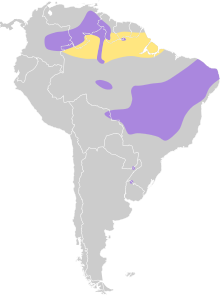| Least nighthawk | |
|---|---|

| |
| Scientific classification | |
| Domain: | Eukaryota |
| Kingdom: | Animalia |
| Phylum: | Chordata |
| Class: | Aves |
| Clade: | Strisores |
| Order: | Caprimulgiformes |
| Family: | Caprimulgidae |
| Genus: | Chordeiles |
| Species: | C. pusillus
|
| Binomial name | |
| Chordeiles pusillus Gould, 1861
| |

| |
The least nighthawk (Chordeiles pusillus) is a species of nightjar in the family Caprimulgidae. It is found in Argentina, Bolivia, Brazil, Colombia, Guyana, Suriname, and Venezuela.[2][3]
Taxonomy and systematics
Early in the 20th century the least nighthawk was assigned to its own genus, Nannochordeiles, but since the middle of the century has been included in Chordeiles.[4] It has these six subspecies:[2]
- C. p. septentrionalis - Hellmayr (1908)
- C. p. esmeraldae - Zimmer & Phelps (1947)
- C. p. xerophilus - Dickerman (1988)
- C. p. novaesi - Dickerman (1988)
- C. p. saturatus - Pinto & Camargo (1957)
- C. p. pucillis - Gould (1861)
Two specimens from northeastern Argentina might represent a seventh subspecies.[5]
Description
The least nighthawk is 15 to 25 cm (5.9 to 9.8 in) long, making it one of the smallest species in family Caprimulgidae. Two females weighed 27.8 and 33.4 g (0.98 and 1.18 oz) The general plumage pattern is brown upperparts with gray, rufous, and buff spots, and whitish or buff underparts with brown bars. The throat has a narrow white patch or small white patches on either side of it. The four outermost primaries have a white band that is highly visible in flight. Males also have white tips on some other wing feathers. The subspecies vary in size, colors, and the extent of the barring on the underparts.[5]
Distribution and habitat
The six subspecies of least nighthawk are distributed thus. The subspecies of the two records in Argentina has not been determined.[2][5]
- C. p. septentrionalis, eastern Colombia through northern Venezuela and Guyana into western Suriname and northern Brazil
- C. p. esmeraldae, southeastern Colombia, southern Venezuela, and extreme northwestern Brazil
- C. p. xerophilus, Paraíba and Pernambuco states in extreme northeastern Brazil
- C. p. novaesi, Maranhão and Piauí states in northeastern Brazil
- C. p. saturatus, southeastern Amazonas, southwestern Pará, and western Mato Grosso states in west-central Brazil and extreme eastern Bolivia.
- C. p. pucillis, Tocantins, Bahia, and Goiás states in eastern Brazil
The least nighthawk typically inhabits open savanna or subtropical grassland, both cerrado and caatinga. In elevation it ranges from sea level up to about 1,000 m (3,300 ft).[5]
Behavior
Movement
Some populations of least nighthawk appear to be migratory but the data are inconclusive.[5]
Feeding
The least nighthawk is an aerial insectivore, taking prey of many insect orders. It hunts at dawn and late in dusk and tends to stay near the ground. It hunts in solitary, in pairs, or in small loose groups. Its flight has been described as "buoyant, quick, and erratic with many sudden shifts in direction".[5]
Breeding
Very little is known about the least nighthawk's breeding phenology. Its nesting season appears to vary within its range. It lays one egg directly on the ground.[5]
Vocalization
The least nighthawk's flight call has been variously described as "a low churr and a weak nasal beep or week" and as "a short, sharp whit or bit". It sings from the ground or a bush, "a fast cur-cur-cur-curry (or chu-chu-chu-chu-chuEE).[5]
Status
The IUCN has assessed the least nighthawk as being of Least Concern. It has a wide distribution, its population is thought to be stable, and no threats have been identified.[1]
References
- ^ a b BirdLife International (2018). "Least Nighthawk Chordeiles pusillus". IUCN Red List of Threatened Species. 2018. Retrieved 3 October 2021.
- ^ a b c Gill, F.; Donsker, D.; Rasmussen, P. (July 2021). "IOC World Bird List (v 11.2)". Retrieved July 14, 2021.
- ^ Remsen, J. V., Jr., J. I. Areta, E. Bonaccorso, S. Claramunt, A. Jaramillo, D. F. Lane, J. F. Pacheco, M. B. Robbins, F. G. Stiles, and K. J. Zimmer. Version 24 August 2021. Species Lists of Birds for South American Countries and Territories. https://www.museum.lsu.edu/~Remsen/SACCCountryLists.htm retrieved August 24, 2021
- ^ Remsen, J. V., Jr., J. I. Areta, E. Bonaccorso, S. Claramunt, A. Jaramillo, D. F. Lane, J. F. Pacheco, M. B. Robbins, F. G. Stiles, and K. J. Zimmer. Version 24 August 2021. A classification of the bird species of South America. American Ornithological Society. https://www.museum.lsu.edu/~Remsen/SACCBaseline.htm retrieved August 24, 2021
- ^ a b c d e f g h Hellmich, D. (2020). Least Nighthawk (Chordeiles pusillus), version 1.0. In Birds of the World (T. S. Schulenberg, Editor). Cornell Lab of Ornithology, Ithaca, NY, USA. https://doi.org/10.2173/bow.leanig1.01 retrieved October 3, 2021


